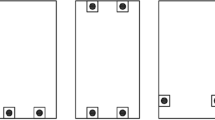Abstract
Engineered bamboo, produced through the technique of gluing and reconstituting, has better mechanical properties than round bamboo and some wood products. This paper studies the flexural performance of laminated beams produced with timber and engineered bamboo. The six-layer beams were made from Douglas fir, spruce, bamboo scrimber and laminated bamboo, or a combination of these. It is confirmed that glued-laminated wood beams produced with wood of weak strength, like spruce, can be strengthened by gluing engineered bamboo lumbers on the outer faces, thus achieving better utilization of the fast growing economic wood species. Flexural failure of the laminated beams was primarily triggered by tensile fracture of the bottom fiber in mid-span, followed by horizontal tearing beside the broken surface. No relative slip between layers was observed before failure, therefore the flexural capacity of the laminated beams can be predicted using equilibrium and compatibility conditions according to the plane section assumption.







Similar content being viewed by others
References
van der Lugt P, van den Dobbelsteen AAJF, Janssen JJA (2006) An environmental, economic and practical assessment of bamboo as a building material for supporting structures. Constr Build Mater 20(9):648–656
Issa CA, Kmeid Z (2005) Advanced wood engineering: glulam beams. Constr Build Mater 19(2):99–106
Tollefson J (2017) The wooden skyscrapers that could help to cool the planet. Nature 545:280–282
Falk RH (2009) Wood as a sustainable building material. For Prod J 59(9):6–12
Sinha A, Way D, Mlasko S (2014) Structural performance of glued laminated bamboo beams. J Struct Eng 140(1):04013021
Mahdavi M, Clouston PL, Arwade SR (2011) Development of laminated bamboo lumber: review of processing, performance, and economical considerations. J Mater Civil Eng 23(7):1036–1042
Verma CS, Chariar VM (2012) Development of layered laminate bamboo composite and their mechanical properties. Compos Part B Eng 43(3):1063–1069
Amada S, Sun U (2001) Fracture properties of bamboo. Compos Part B Eng 32(5):451–459
Zhou AP, Huang DS, Li HT, Su Y (2012) Hybrid approach to determine the mechanical parameters of fibers and matrixes of bamboo. Constr Build Mater 35:191–196
Huang DS, Zhou AP, Bian YL (2013) Experimental and analytical study on the nonlinear bending of parallel strand bamboo beams. Constr Build Mater 44:585–592
Moody RC (1974) Design criteria for large structural glued-laminated timber beams using mixed species of visually graded lumber. Forest Products Laboratory, U.S. Department of Agriculture, Forest Service, Madison, Wisconsin
Castro G, Paganini F (2003) Mixed glued laminated timber of poplar and Eucalyptus grandis clones. Holz als Roh und Werkstoff 61(4):291–298
Tomasi R, Parisi MA, Piazza M (2009) Ductile design of glued-laminated timber beams. Pract Period Struct Des Constr 14(3):113–122
American Wood Council (2015) ASD/LRFD Manual for engineered wood construction. Leesburg VA, USA
BS EN 14080 (2013) Timber structures—glued laminated timber and glued solid timber—requirements. British Standards International (BSI), UK
Bulleit WM, Sandberg LB, Woods GJ (1989) Steel-reinforced glued laminated timber. J Struct Eng 115(2):433–444
Borri A, Corradi M (2011) Strengthening of timber beams with high strength steel cords. Compos Part B Eng 42(6):1480–1491
Yang HF, Liu WQ, Lu WD, Zhu SJ, Geng QF (2016) Flexural behavior of FRP and steel reinforced glulam beams: experimental and theoretical evaluation. Constr Build Mater 106:550–563
Plevris N, Triantafillou TC (1992) FRP-reinforced wood as structural material. J Mater Civil Eng 4(3):300–317
Gentile C, Svecova D, Rizkalla SH (2002) Timber beams strengthened with GFRP bars: development and applications. J Compos Constr 6(1):11–20
Dempsey DD, Scott DW (2006) Wood members strengthened with mechanically fastened FRP strips. J Compos Constr 10(5):392–398
Osmannezhad S, Faezipour M, Ebrahimi G (2014) Effects of GFRP on bending strength of glulam made of poplar (Populus deltoids) and beech (Fagusorientalis). Constr Build Mater 51:34–39
Corradi M, Borri A, Righetti L, Speranzini E (2017) Uncertainty analysis of FRP reinforced timber beams. Compos Part B Eng 113:174–184
Borri A, Corradi M, Speranzini E (2013) Reinforcement of wood with natural fibers. Compos Part B Eng 53(7):1–8
Ferrier E, Labossiere P, Neale KW (2009) Mechanical behavior of an innovative hybrid beam made of glulam and ultrahigh-performance concrete reinforced with FRP or steel. J Compos Constr 14(2):217–223
ASTM D198-15 (2015) Standard test methods of static tests of lumber in structural sizes. American society for testing and materials (ASTM), West Conshohocken, USA
ISO 22157-1 (2004) Bamboo—determination of physical and mechanical properties—part 1: requirements. International Standards Organisation (ISO), Geneva, Switzerland
JG/T 199-2007 (2007) Testing method for physical and mechanical properties of bamboo used in building. Ministry of Housing and Urban-Rural Development of the People’s Republic of China (MOHURD), Beijing, China (in Chinese)
ISO 22156: 2004 (2012) Bamboo—structural design. International Standards Organisation (ISO), Geneva, Switzerland
ASTM D143-14 (2014) Standard test methods for small clear specimens of timber. American society for testing and materials (ASTM), West Conshohocken, USA
Eurocode 5 (2003) Design of timber structures—part 1-1: general rules and rules for buildings (EN 1995-1-1:2004+A2:2014). European Committee for Standardization, Brussels, Belgium
Long WG, Yang XB, Wang YW (2005) Design manual for timber structures, 3rd edn. China Architecture and Building Press, Beijing (in Chinese)
Acknowledgements
The authors gratefully acknowledge the financial support from the National Key R&D Program of China (Grant No. 2017YFC0703503), and R&D Project of Ministry of Housing and Urban–Rural Development of People’s Republic of China (Grant No. 2016-K5-017).
Author information
Authors and Affiliations
Corresponding author
Ethics declarations
Conflict of interest
The authors declare that they have no conflict of interest.
Electronic supplementary material
Below is the link to the electronic supplementary material.
Rights and permissions
About this article
Cite this article
Xu, Q., Leng, Y., Chen, X. et al. Experimental study on flexural performance of glued-laminated-timber-bamboo beams. Mater Struct 51, 9 (2018). https://doi.org/10.1617/s11527-017-1135-2
Received:
Accepted:
Published:
DOI: https://doi.org/10.1617/s11527-017-1135-2




